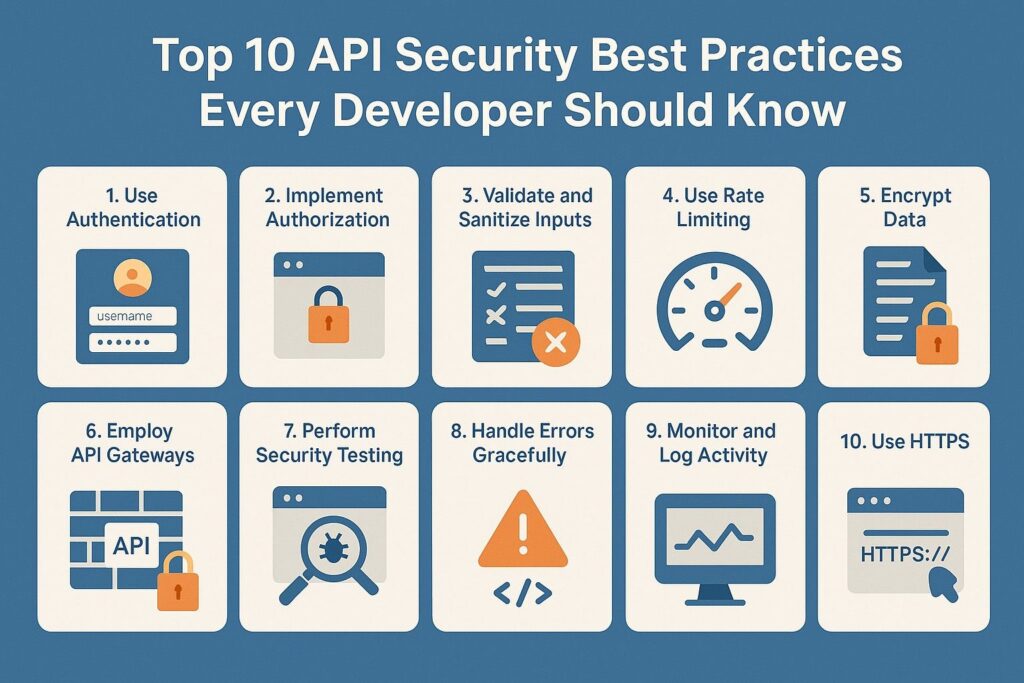
APIs are a critical part of modern applications, enabling data exchange and integration across platforms, services, and devices. However, this connectivity also opens up potential attack vectors. A poorly secured API can expose sensitive data, compromise user trust, and serve as an entry point for attackers.
Below are 10 essential API security best practices every developer, architect, or DevOps professional must follow to build secure and resilient APIs.
1. Use HTTPS Everywhere
Never allow unencrypted traffic.
- Encrypt all API communication using HTTPS to protect against man-in-the-middle (MITM) attacks.
- Use TLS 1.2 or higher and renew certificates regularly.
- Redirect all HTTP traffic to HTTPS.
- Enforce HSTS (HTTP Strict Transport Security) to force HTTPS use on supported clients.
2. Implement Strong Authentication and Authorization
Ensure only legitimate users and systems access your APIs.
- Use OAuth 2.0 and OpenID Connect for secure and standardized user authentication.
- For server-to-server communication, use JWTs (JSON Web Tokens), mutual TLS, or API keys.
- Enforce Role-Based Access Control (RBAC) to restrict data and method access.
- Never expose sensitive endpoints without authorization checks, even if they seem harmless.
3. Validate and Sanitize All Input
Treat all client input as untrusted.
- Use whitelisting over blacklisting for input validation.
- Use schema validators like Joi, Yup, or JSON Schema to enforce strict typing and field constraints.
- Strip or encode any user input that might be rendered in responses to prevent XSS.
- Prevent injection attacks (SQL, NoSQL, command injection) by using parameterized queries and ORM sanitization.
4. Use Rate Limiting and Throttling
Protect APIs from abuse and denial-of-service attacks.
- Implement rate limiting at the API level using middleware or API gateway tools.
- Apply differentiated limits: e.g., stricter limits for anonymous users, more lenient for authenticated users.
- Respond with HTTP 429 (Too Many Requests) when limits are exceeded.
- Consider IP-based, user-based, or API key-based rate limiting depending on your architecture.
5. Keep APIs and Dependencies Up-to-Date
Outdated components are prime targets for attackers.
- Perform regular security audits of dependencies using tools like
npm audit,Snyk, orOWASP Dependency-Check. - Monitor and patch vulnerabilities as soon as updates become available.
- Remove unused packages and deprecated code.
- Subscribe to security advisories for your frameworks and libraries.
6. Use Proper Error Handling
Avoid leaking implementation details through error responses.
- Return generic and consistent error messages to users (e.g., “An error occurred”).
- Use appropriate HTTP status codes (e.g., 400 for bad requests, 401 for unauthorized).
- Log full error details (stack traces, internal states) securely on the server side only.
- Never expose stack traces, database errors, or environment variables to the client.
7. Secure Your Data
Data protection must be end-to-end.
- Encrypt sensitive data at rest and in transit.
- Use bcrypt or Argon2 for password hashing—never store passwords as plaintext.
- Apply field-level encryption for personally identifiable information (PII).
- Tokenize or mask sensitive fields in logs and API responses.
8. Enable CORS Safely
Control cross-origin interactions.
- Use strict CORS policies by whitelisting trusted domains.
- Avoid using
*forAccess-Control-Allow-Originin production. - Only allow required methods and headers (
GET,POST, etc.). - Review and test CORS settings frequently, especially after frontend/backend updates.
9. Use API Gateways and Firewalls
Protect your backend by fronting it with dedicated security layers.
- Use API gateways (e.g., AWS API Gateway, Kong, Apigee) for rate limiting, authentication, and monitoring.
- Deploy Web Application Firewalls (WAFs) to block known attack patterns (SQLi, XSS, etc.).
- Apply security policies, quotas, caching, and traffic shaping via the gateway.
- Segment public APIs from internal services using separate gateways or subnets.
10. Monitor, Audit, and Log Everything
Visibility is key to detecting and responding to threats.
- Log all API requests and responses, including IPs, tokens used, and response codes.
- Centralize logs using tools like ELK Stack, Datadog, or Splunk.
- Set up real-time alerts for unusual behaviors: login failures, spikes in usage, etc.
- Perform regular audits and retain logs for forensic analysis and compliance.
Final Thoughts
API security is not a one-time task—it’s a continuous process that must evolve with your application and threat landscape. Whether you are building internal microservices or public APIs, security must be integrated from the design phase and maintained throughout the software lifecycle.
By applying these 10 best practices, you can significantly reduce the risk of data breaches, protect user privacy, and build APIs that are trusted, robust, and scalable.
Let security be a default requirement, not an afterthought.

I’m Shreyash Mhashilkar, an IT professional who loves building user-friendly, scalable digital solutions. Outside of coding, I enjoy researching new places, learning about different cultures, and exploring how technology shapes the way we live and travel. I share my experiences and discoveries to help others explore new places, cultures, and ideas with curiosity and enthusiasm.






